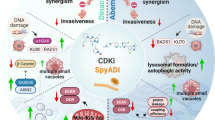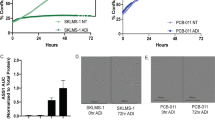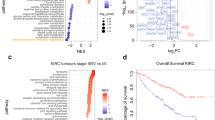Abstract
Many human malignancies lack de novo biosynthesis of arginine (Arg) as the key enzyme argininosuccinate synthetase 1 (ASS1) is silenced. These tumors acquire ectopic Arg for survival, and depleting this source by Arg-depleting recombinant enzyme ADI-PEG20 results in cell death. Mechanisms underlying Arg auxotrophy in these tumors and how they respond to Arg-auxotrophic stress are poorly understood. Here, we report that an immediate-early event of Arg-auxotrophic response involves reactive oxygen species-mediated secretion of Gas6, which interacts with its receptor Axl and activates the downstream Ras/PI3K/Akt growth signal leading to accumulation of c-Myc by protein stabilization. Arg-auxotrophic challenge also transcriptionally upregulates c-Myc expression, which provides a feedback mechanism to enhance Axl expression. c-Myc is a positive regulator of ASS1, but elevated ASS1 provides a feedback mechanism to suppress c-Myc and Axl. Our results revealed multiple inter-regulatory pathways in Arg-auxotrophic response, consisting of Axl, c-Myc and ASS1, which regulate Arg homeostasis and ADI-PEG20 sensitivity. These pathways provide potential targets for improving the efficacy of treating Arg-auxotrophic tumors using Arg-deprivation strategies.
This is a preview of subscription content, access via your institution
Access options
Subscribe to this journal
Receive 50 print issues and online access
$259.00 per year
only $5.18 per issue
Buy this article
- Purchase on Springer Link
- Instant access to full article PDF
Prices may be subject to local taxes which are calculated during checkout








Similar content being viewed by others
References
Beaudet AL, O'Brien WE, Bock HG, Freytag SO, Su TS . The human argininosuccinate synthetase locus and citrullinemia. Adv Hum Genet 1986; 15: 291–162.
Feun L, Savaraj N . Pegylated arginine deiminase: a novel anticancer enzyme agent. Exp Opin Invest Drugs 2006; 15: 815–822.
Kuo MT, Savaraj N, Feun LG . Targeted cellular metabolism for cancer chemotherapy with recombinant arginine-degrading enzymes. Oncotarget 2010; 1: 246–251.
Phillips MM, Sheaff MT, Szlosarek PW . Targeting arginine-dependent cancers with arginine-degrading enzymes: opportunities and challenges. Cancer Res Treat 2013; 45: 251–262.
Tsai WB, Aiba I, Lee SY, Feun L, Savaraj N, Kuo MT . Resistance to arginine deiminase treatment in melanoma cells is associated with induced argininosuccinate synthetase expression involving c-Myc/HIF-1alpha/Sp4. Mol Cancer Ther 2009; 8: 3223–3233.
Tsai WB, Aiba I, Long Y, Lin HK, Feun L, Savaraj N et al. Activation of Ras/PI3K/ERK pathway induces c-Myc stabilization to upregulate argininosuccinate synthetase, leading to arginine deiminase resistance in melanoma cells. Cancer Res 2012; 72: 2622–2633.
Ekman C, Stenhoff J, Dahlback B . Gas6 is complexed to the soluble tyrosine kinase receptor Axl in human blood. J Thromb Haemost 2010; 8: 838–844.
Sasaki T, Knyazev PG, Clout NJ, Cheburkin Y, Gohring W, Ullrich A et al. Structural basis for Gas6-Axl signalling. EMBO J 2006; 25: 80–87.
Holbrook AM, Pereira JA, Labiris R, McDonald H, Douketis JD, Crowther M et al. Systematic overview of warfarin and its drug and food interactions. Arch Intern Med 2005; 165: 1095–1106.
Feneyrolles C, Spenlinhauer A, Guiet L, Fauvel B, Dayde-Cazals B, Warnault P et al. Axl kinase as a key target for oncology: focus on small molecule inhibitors. Mol Cancer Ther 2014; 13: 2141–2148.
Khoury HJ, Cortes JE, Kantarjian HM, Gambacorti-Passerini C, Baccarani M, Kim DW et al. Bosutinib is active in chronic phase chronic myeloid leukemia after imatinib and dasatinib and/or nilotinib therapy failure. Blood 2012; 119: 3403–3412.
Trask PC, Cella D, Besson N, Kelly V, Masszi T, Kim DW . Health-related quality of life of bosutinib (SKI-606) in imatinib-resistant or imatinib-intolerant chronic phase chronic myeloid leukemia. Leuk Res 2012; 36: 438–442.
Zhang YX, Knyazev PG, Cheburkin YV, Sharma K, Knyazev YP, Orfi L et al, AXL is a potential target for therapeutic intervention in breast cancer progression. Cancer Res 2008; 68: 1905–1915.
Long Y, Tsai WB, Wangpaichitr M, Tsukamoto T, Savarah N, Feun LG et al. Arginine deiminase resistance in melanoma cells is associated with metabolic reprogramming, glucose dependence and glutamine addiction. Mol Cancer Ther 2013; 12: 2581–2590.
Kodigepalli KM, Bowers K, Sharp A, Nanjundan M . Roles and regulation of phospholipid scramblases. FEBS Lett 2015; 589: 3–14.
Suzuki J, Nagata S . Phospholipid scrambling on the plasma membrane. Methods Enzymol 2014; 544: 381–393.
Segawa K, Suzuki J, Nagata S . Flippases and scramblases in the plasma membrane. Cell Cycle 2014; 13: 2990–2991.
Graham DK, DeRyckere D, Davies KD, Earp HS . The TAM family: phosphatidylserine-sensing receptor tyrosine kinases gone awry in cancer. Nat Rev Cancer 2014; 14: 769–785.
Lemke G . Biology of the TAM receptors. Cold Spring Harbor Perspect Biol 2013; 5: a009076.
Nickel W . Pathways of unconventional protein secretion. Curr Opin Biotechnol 2010; 21: 621–626.
Chardin P, McCormick F, Brefeldin A . the advantage of being uncompetitive. Cell 1999; 97: 153–155.
Saenz JB, Sun WJ, Chang JW, Li J, Bursulaya B, Gray NS et al. Golgicide A reveals essential roles for GBF1 in Golgi assembly and function. Nat Chem Biol 2009; 5: 157–165.
Sasaki T, Knyazev PG, Cheburkin Y, Gohring W, Tisi D, Ullrich A et al. Crystal structure of a C-terminal fragment of growth arrest-specific protein Gas6. Receptor tyrosine kinase activation by laminin G-like domains. J Biol Chem 2002; 277: 44164–44170.
Konishi A, Aizawa T, Mohan A, Korshunov VA, Berk BC . Hydrogen peroxide activates the Gas6-Axl pathway in vascular smooth muscle cells. J Biol Chem 2004; 279: 28766–28770.
Neel BG, Gu H, Pao L . The 'Shp'ing news: SH2 domain-containing tyrosine phosphatases in cell signaling. Trends Biochem Sci 2003; 28: 284–293.
Syed N, Langer J, Janczar K, Singh P, Lo Nigro C, Lattanzio L et al. Epigenetic status of argininosuccinate synthetase and argininosuccinate lyase modulates autophagy and cell death in glioblastoma. Cell Death Dis 2013; 4: e458.
Haines RJ, Corbin KD, Pendleton LC, Eichler DC . Protein kinase Calpha phosphorylates a novel argininosuccinate synthase site at serine 328 during calcium-dependent stimulation of endothelial nitric-oxide synthase in vascular endothelial cells. J Biol Chem 2012; 287: 26168–26176.
Huang Z, Wang TS, Zhao YC, Zuo RJ, Deng WB, Chi YJ et al. Cyclic adenosine monophosphate-induced argininosuccinate synthase 1 expression is essential during mouse decidualization. Mol Cell Endocrinol 2014; 388: 20–31.
Goodwin BL, Corbin KD, Pendleton LC, Levy MM, Solomonson LP, Eichler DC . Troglitazone up-regulates vascular endothelial argininosuccinate synthase. Biochem Biophys Res Commun 2008; 370: 254–258.
Feun LG, Marini A, Walker G, Elgart G, Moffat F, Rodgers SE et al. Negative argininosuccinate synthetase expression in melanoma tumours may predict clinical benefit from arginine-depleting therapy with pegylated arginine deiminase. Br J Cancer 2012; 106: 1481–1485.
Stitt TN, Conn G, Gore M, Lai C, Bruno J, Radziejewski C et al. The anticoagulation factor protein S and its relative, Gas6, are ligands for the Tyro 3/Axl family of receptor tyrosine kinases. Cell 1995; 80: 661–670.
Nagata K, Ohashi K, Nakano T, Arita H, Zong C, Hanafusa H et al. Identification of the product of growth arrest-specific gene 6 as a common ligand for Axl, Sky, and Mer receptor tyrosine kinases. J Biol Chem 1996; 271: 30022–30027.
Laurance S, Lemarie CA, Blostein MD . Growth arrest-specific gene 6 (gas6) and vascular hemostasis. Adv Nutr 2012; 3: 196–203.
Paccez JD, Vogelsang M, Parker MI, Zerbini LF . The receptor tyrosine kinase Axl in cancer: biological functions and therapeutic implications. Int J Cancer 2014; 134: 1024–1033.
Verma A, Warner SL, Vankayalapati H, Bearss DJ, Sharma S . Targeting Axl and Mer kinases in cancer. Mol Cancer Ther 2011; 10: 1763–1773.
Gjerdrum C, Tiron C, Hoiby T, Stefansson I, Haugen H, Sandal T et al. Axl is an essential epithelial-to-mesenchymal transition-induced regulator of breast cancer metastasis and patient survival. Proc Natl Acad Sci USA 2010; 107: 1124–1129.
Rochlitz C, Lohri A, Bacchi M, Schmidt M, Nagel S, Fopp M et al. Axl expression is associated with adverse prognosis and with expression of Bcl-2 and CD34 in de novo acute myeloid leukemia (AML): results from a multicenter trial of the Swiss Group for Clinical Cancer Research (SAKK). Leukemia 1999; 13: 1352–1358.
Wu X, Liu X, Koul S, Lee CY, Zhang Z, Halmos B . AXL kinase as a novel target for cancer therapy. Oncotarget 2014; 5: 9546–9563.
Byers LA, Diao L, Wang J, Saintigny P, Girard L, Peyton M et al. An epithelial–mesenchymal transition gene signature predicts resistance to EGFR and PI3K inhibitors and identifies Axl as a therapeutic target for overcoming EGFR inhibitor resistance. Clin Cancer Res 2013; 19: 279–290.
Giles KM, Kalinowski FC, Candy PA, Epis MR, Zhang PM, Redfern AD et al. Axl mediates acquired resistance of head and neck cancer cells to the epidermal growth factor receptor inhibitor erlotinib. Mol Cancer Ther 2013; 12: 2541–2558.
Zhang Z, Lee JC, Lin L, Olivas V, Au V, LaFramboise T et al. Activation of the AXL kinase causes resistance to EGFR-targeted therapy in lung cancer. Nat Genet 2012; 44: 852–860.
Johannessen CM, Boehm JS, Kim SY, Thomas SR, Wardwell L, Johnson LA et al. COT drives resistance to RAF inhibition through MAP kinase pathway reactivation. Nature 2010; 468: 968–972.
Cirone P, Andresen CJ, Eswaraka JR, Lappin PB, Bagi CM . Patient-derived xenografts reveal limits to PI3K/mTOR- and MEK-mediated inhibition of bladder cancer. Cancer Chemother Pharmacol 2014; 73: 525–538.
Qiu F, Chen YR, Liu X, Chu CY, Shen LJ, Xu J et al. Arginine starvation impairs mitochondrial respiratory function in ASS1-deficient breast cancer cells. Sci Signal 2014; 7: ra31.
Erez A . Argininosuccinic aciduria: from a monogenic to a complex disorder. Genet Med 2013; 15: 251–257.
Erez A, Nagamani SC, Shchelochkov OA, Premkumar MH, Campeau PM, Chen Y et al. Requirement of argininosuccinate lyase for systemic nitric oxide production. Nat Med 2011; 17: 1619–1626.
Conacci-Sorrell M, McFerrin L, Eisenman RN . An overview of MYC and its interactome. Cold Spring Harbor Perspect Med 2014; 4: a014357.
Hara K, Yonezawa K, Weng QP, Kozlowski MT, Belham C, Avruch J . Amino acid sufficiency and mTOR regulate p70 S6 kinase and eIF-4E BP1 through a common effector mechanism. J Biol Chem 1998; 273: 14484–14494.
Amati B, Brooks MW, Levy N, Littlewood TD, Evan GI, Land H . Oncogenic activity of the c-Myc protein requires dimerization with Max. Cell 1993; 72: 233–245.
Kretzner L, Blackwood EM, Eisenman RN . Myc and Max proteins possess distinct transcriptional activities. Nature 1992; 359: 426–429.
Wiese KE, Walz S, von Eyss B, Wolf E, Athineos D, Sansom O et al. The role of MIZ-1 in MYC-dependent tumorigenesis. Cold Spring Harbor Perspect Med 2013; 3: a014290.
Rahl PB, Lin CY, Seila AC, Flynn RA, McCuine S, Burge CB et al. c-Myc regulates transcriptional pause release. Cell 2010; 141: 432–445.
Trask PC, Cella D, Powell C, Reisman A, Whiteley J, Kelly V . Health-related quality of life in chronic myeloid leukemia. Leuk Res 2013; 37: 9–13.
Walz S, Lorenzin F, Morton J, Wiese KE, von Eyss B, Herold S et al. Activation and repression by oncogenic MYC shape tumour-specific gene expression profiles. Nature 2014; 511: 483–487.
Kimball SR, Horetsky RL, Jefferson LS . Implication of eIF2B rather than eIF4E in the regulation of global protein synthesis by amino acids in L6 myoblasts. J Biol Chem 1998; 273: 30945–30953.
Shan J, Fu L, Balasubramanian MN, Anthony T, Kilberg MS . ATF4-dependent regulation of the JMJD3 gene during amino acid deprivation can be rescued in Atf4-deficient cells by inhibition of deacetylation. J Biol Chem 2012; 287: 36393–36403.
Kilberg MS, Balasubramanian M, Fu L, Shan J . The transcription factor network associated with the amino acid response in mammalian cells. Adv Nutr 2012; 3: 295–306.
Jackson RJ, Hellen CU, Pestova TV . The mechanism of eukaryotic translation initiation and principles of its regulation. Nat Rev Mol Cell Biol 2010; 11: 113–127.
Kimball SR, Jefferson LS . Control of translation initiation through integration of signals generated by hormones, nutrients, and exercise. J Biol Chem 2010; 285: 29027–29032.
Griffin JH, Gruber A, Fernandez JA . Reevaluation of total, free, and bound protein S and C4b-binding protein levels in plasma anticoagulated with citrate or hirudin. Blood 1992; 79: 3203–3211.
Suh CH, Hilliard B, Li S, Merrill JT, Cohen PL . TAM receptor ligands in lupus: protein S but not Gas6 levels reflect disease activity in systemic lupus erythematosus. Arthritis Res Ther 2010; 12: R146.
Holland SJ, Pan A, Franci C, Hu Y, Chang B, Li W et al. R428, a selective small molecule inhibitor of Axl kinase, blocks tumor spread and prolongs survival in models of metastatic breast cancer. Cancer Res 2010; 70: 1544–1554.
Ye X, Li Y, Stawicki S, Couto S, Eastham-Anderson J, Kallop D et al. An anti-Axl monoclonal antibody attenuates xenograft tumor growth and enhances the effect of multiple anticancer therapies. Oncogene 2010; 29: 5254–5264.
Acknowledgements
We thank Drs Bor-Wen Wu and John S Bomalaski (Polaris Pharmacologies) for ADI-PEG20 and anti-ASS1 antibody, Drs RM Melillo, S Jakob and WB Ou for recombinant DNAs. This research was supported in part by the NIH/NCI Grants R01 CA149260 (to MTK) and P30CA16672 (MD Anderson Core).
Author information
Authors and Affiliations
Corresponding author
Ethics declarations
Competing interests
The authors declare no conflict of interest.
Additional information
Supplementary Information accompanies this paper on the Oncogene website
Supplementary information
Rights and permissions
About this article
Cite this article
Tsai, WB., Long, Y., Park, JR. et al. Gas6/Axl is the sensor of arginine-auxotrophic response in targeted chemotherapy with arginine-depleting agents. Oncogene 35, 1632–1642 (2016). https://doi.org/10.1038/onc.2015.237
Received:
Revised:
Accepted:
Published:
Issue Date:
DOI: https://doi.org/10.1038/onc.2015.237
This article is cited by
-
The addition of arginine deiminase potentiates Mithramycin A-induced cell death in patient-derived glioblastoma cells via ATF4 and cytochrome C
Cancer Cell International (2023)
-
Targeting TAM to Tame Pancreatic Cancer
Targeted Oncology (2020)
-
Chromatin remodeling system p300-HDAC2-Sin3A is involved in Arginine Starvation-Induced HIF-1α Degradation at the ASS1 promoter for ASS1 Derepression
Scientific Reports (2017)



